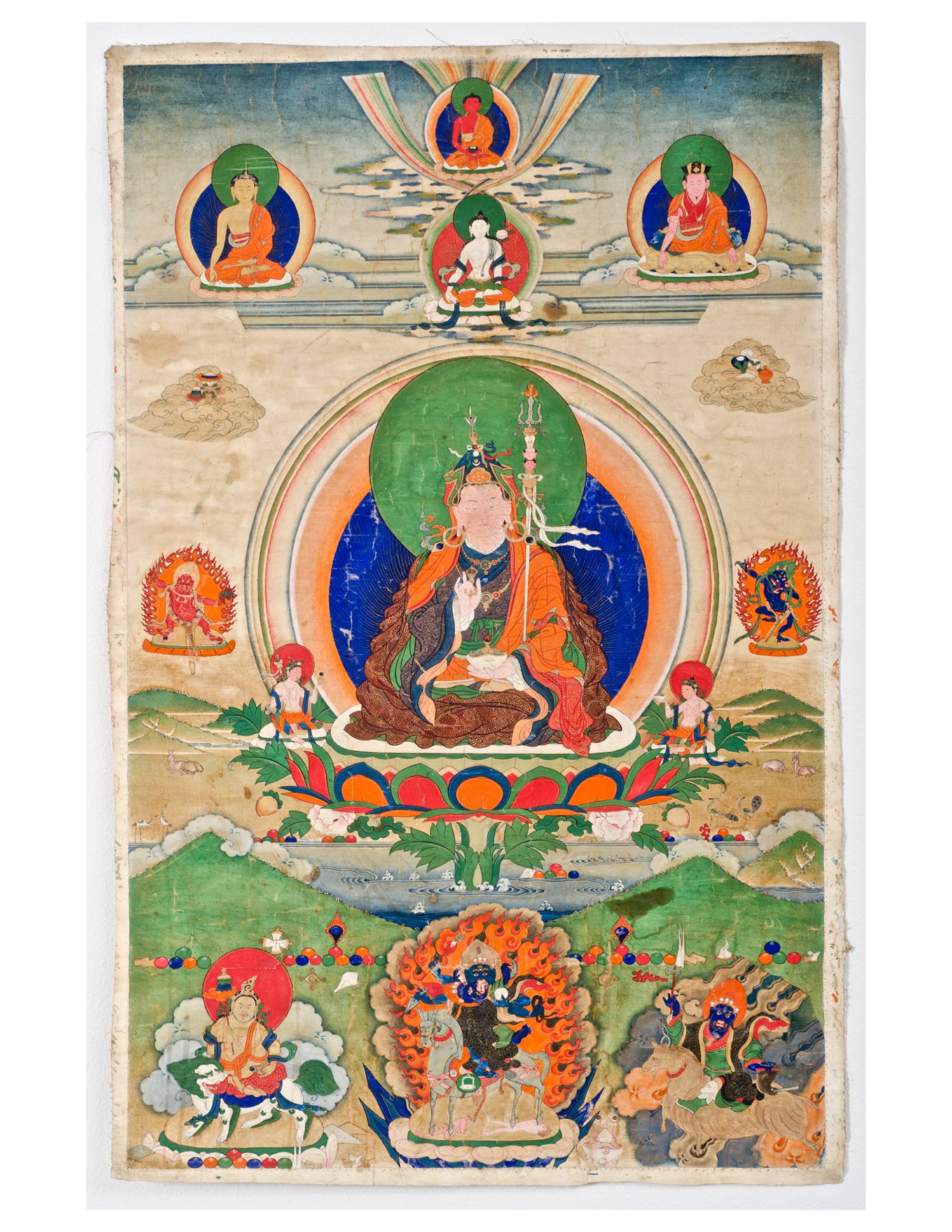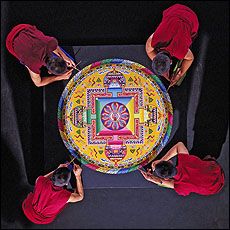PAST EXHIBITION
Into the Sacred City: Tibetan Buddhist Deities from the Theos Bernard Collection
OPENS
September 16, 2012
CLOSES
January 13, 2013
SHARE
About the Exhibit
September 16, 2012 – January 13, 2013

Padmasambhava, 18th-19th century
Colors on cotton, 53 x 38 in.
University of California, Berkeley Art Museum and Pacific Film Archive, Bequest of G. Eleanore Murray
In a presentation exclusive to the Blanton Museum of Art at The University of Texas at Austin, eight rare and never-before publicly exhibited Tibetan works from the University of California, Berkeley Art Museum and Pacific Film Archive (BAM/PFA) will be on view September 16, 2012 through January 13, 2013. Into the Sacred City: Tibetan Buddhist Deities from the Theos Bernard Collection explores the rich art and religion of this fascinating region through five mandalas and three thangkas dating from the fifteenth to twentieth centuries.
Originally used to explain Buddhist teachings to early nomadic Tibetans, thangkas are meticulously detailed hanging scroll paintings on silk that also serve as meditation aids in Buddhist ritual practice. The works in the Blanton’s presentation feature fierce and sublime deities such as Mahakala, a protector of monasteries, and Avalokiteshvara, the bodhisattva of compassion. Mandalas are elaborate, intricate circular diagrams reflecting a sacred, idealized universe. They are created as a spiritual exercise and are used in meditation to guide individuals along the path to enlightenment.
As a special program accompanying the exhibition, the Blanton has invited 10 monks from the Drepung Loseling Monastery in Atlanta to create a 5-foot sand mandala in the museum’s Rapoport Atrium. The sand mandala project will begin on January 9 and run for five days. The public is invited to view the active creation of the piece and its associated sacred ceremonies.
“This exhibition provides the community the unique opportunity to engage with centuries-old Tibetan art,” said Blanton director Simone Wicha. “Many of the pieces were restored for this exhibition and have never been seen before by the public. These beautiful objects offer an enlightening view into the ancient culture of this important part of the world.”
All of the works in the exhibition come to The Blanton from the Theos Bernard Collection of BAM/PFA. In 1937, after spending a year in India studying yoga and Tibetan language, the adventurer and scholar Theos Bernard was among the first westerners given permission to enter the legendary city of Lhasa in central Tibet. Granted unprecedented access to study Tibetan culture and beliefs firsthand, he became the first American ever initiated into the rites of Tibetan Buddhism. He documented his journey extensively through film and photographs, capturing Tibet at a pivotal moment in its history. British and American journals widely publicized the travels of this charismatic, self-proclaimed, “White Lama.” Through his memoirs and books such as Hatha Yoga: The Report of a Personal Experience, lecture tours, and founding of the first Tibetan Buddhist research center in the United States, Bernard was one of the most influential voices introducing yoga and Tibetan culture to America. In 1947, he vanished mysteriously in the Himalayas while in search of rare manuscripts. Today, scholars continue to unearth new details about Bernard’s life and to reinterpret the actions and legacy of this controversial figure.
Julia M. White, senior curator of Asian art at BAM/PFA, organized the exhibition exclusively for the Blanton, and the presentation this fall will be the first time the works have ever been publicly displayed. The delicate works previously suffered from condition problems and were conserved especially for the exhibition by Seattle-based Asian art conservator Ephraim Jose, whose experience includes extensive work on Tibetan and Bhutanese objects in this country and in Bhutan, where he has, at the invitation of the Bhutanese king, established a school to train Buddhist monks in the preservation of their most sacred art.
Into the Sacred City: Tibetan Buddhist Deities from the Theos Bernard Collection is organized by Julia M. White, Senior Curator of Asian Art, University of California, Berkeley Art Museum and Pacific Film Archive.
Support for the exhibition and related programming is provided by Judy and Charles Tate, Leslie and Jack Blanton, Jr., Jessica and Jimmy Younger, the E. Rhodes and Leona B. Carpenter Foundation, and The Freeman Foundation.
Download the Into the Sacred City Gallery Guides:
Related Programming
During regular museum hours Wednesday, Jan. 9 – Sunday, Jan. 13, 2013 | Sand Mandala Project
Wednesday, Jan. 9, 12:30 – 1:30 p.m. | Sand Mandala Project Opening Ceremony
Thursday, Jan. 10, 12:30 p.m. | Public Tour: Into the Sacred City
Saturday, Jan. 12, 2 – 3 p.m. | Lecture: Symbolism of the Sand Mandala
Saturday, Jan. 12, 3 p.m.| Public Tour: Into the Sacred City
Sunday, Jan. 13, 2 – 4:30 p.m.| Sand Mandala Project Closing Ceremony
MORE ABOUT THE SAND MANDALA PROJECT

Led by 10 Buddhist monks from the Drepung Loseling Monastery, the project will begin on January 9 in the museum’s Rapaport Atrium with an opening consecration ceremony of chanting, music, and mantra recitation, followed by the construction of a 5-foot mandala with millions of grains of colored sand. At the conclusion of the project, the monks will dismantle the piece in a special ceremony signifying the impermanence of all that exists, and then the sand will be dispersed into a local body of water. Sand mandalas are unique to Tibetan Buddhism and are created for the healing of living beings and the environment. Throughout the five-day project, the public will be able to view this unique process in-person, and later through video and photography of the event. The monks also will give a public lecture on the symbolism and meaning of the sand mandala.
Funding for the Sand Mandala Project is provided by Judy and Charles Tate and Leslie and Jack Blanton, Jr. Additional funding is provided by a grant from Humanities Texas, the state affiliate of the National Endowment for the Humanities, and the Carolyn Harris Hynson Centennial Endowment at the Blanton Museum of Art.

